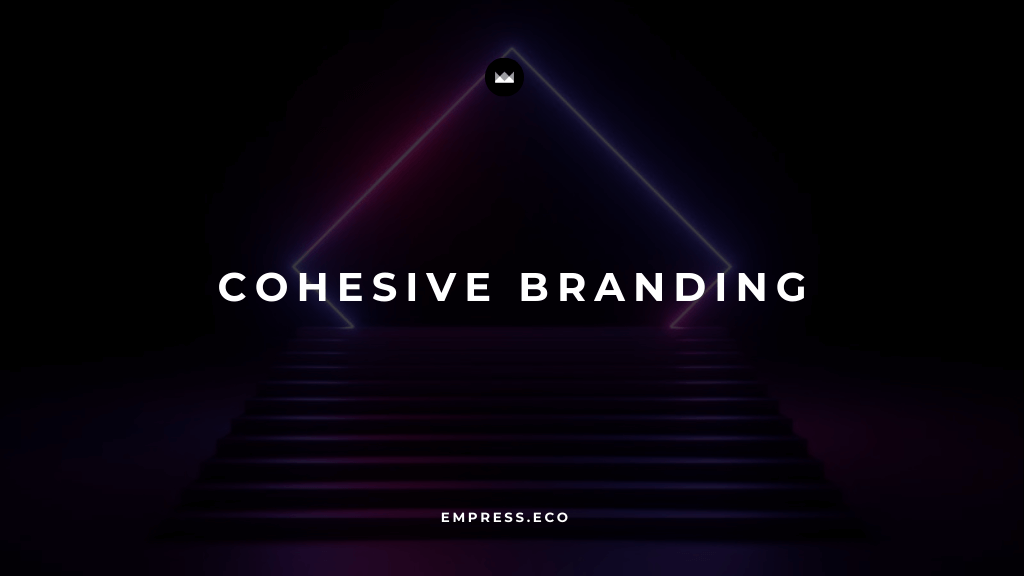
Build Brand Consistency with DADA’s Cohesive Brand Identity Solutions
How a unified brand presence fosters trust, loyalty, and long-term success.
Table of Contents
Creating a cohesive brand identity is essential for building trust, fostering customer loyalty, and achieving long-term success. Consistency in branding not only helps distinguish your brand but also ensures that your message resonates with your audience across all touchpoints. This blog explores the importance of a unified brand presence and provides actionable steps to achieve brand consistency.
Understanding Cohesive Brand Identity
A cohesive brand identity is the consistent presentation of a brand across all platforms and marketing channels. It encompasses visual elements, messaging, and overall brand experience, ensuring that every interaction with the brand reinforces its values and mission. Consistency in branding helps create a recognizable and trustworthy image that resonates with consumers.
Benefits of a Cohesive Brand Identity
Enhanced Brand Recognition
Consistent branding makes it easier for consumers to recognize and remember your brand. By maintaining uniformity in visual elements and messaging, you create a strong brand presence that stands out in a crowded market.
Building Trust and Credibility
A consistent brand identity reassures customers of the quality and reliability of your products or services. Trust is a valuable commodity in business, and a cohesive brand identity is one of the key ways to secure and nurture it.
Increased Customer Loyalty
When consumers have a positive and consistent experience with your brand, they are more likely to remain loyal. Consistency fosters a sense of reliability, making customers more likely to choose your brand over competitors.
Streamlined Marketing Efforts
A cohesive brand identity simplifies marketing efforts by providing a clear framework for all communications. This ensures that all marketing materials are aligned with the brand’s values and objectives, making campaigns more effective.
Key Strategies for Building a Cohesive Brand Identity
Define Your Brand Purpose and Voice
Before you can build a cohesive brand identity, you need to clearly define what your brand represents. This includes your brand’s mission, values, and personality. Use tools like the Golden Circle model, Brand Archetypes framework, and Brand Personality Spectrum to shape your brand’s tone and visual identity.
Steps to Define Your Brand Purpose:
- Mission Statement: Clearly articulate your brand’s mission and what it aims to achieve.
- Core Values: Identify the core values that guide your brand’s actions and decisions.
- Brand Voice: Develop a consistent tone of voice that reflects your brand’s personality and resonates with your audience.
Know Your Target Audience
Understanding your target audience is crucial for creating a brand identity that resonates. Conduct thorough research to learn about your audience’s demographics, preferences, and behaviors. Create detailed buyer personas to guide your branding efforts.
Steps to Understand Your Audience:
- Surveys and Interviews: Gather direct feedback from your audience.
- Analytics: Use tools like Google Analytics and social media insights.
- Competitor Analysis: Study your competitors’ strategies to identify gaps and opportunities.
Develop a Comprehensive Brand Style Guide
A brand style guide is a crucial tool for maintaining consistency across all marketing channels. It outlines the visual and messaging elements of your brand, including logo usage, color palettes, typography, and tone of voice.
Elements of a Brand Style Guide:
- Logo Usage: Guidelines for logo placement, size, and variations.
- Color Palette: Primary and secondary colors that represent your brand.
- Typography: Fonts and styles used in all brand communications.
- Imagery and Icons: Consistent use of images and icons that reflect your brand’s identity.
- Tone of Voice: Guidelines for maintaining a consistent tone in all written communications.
Ensure Consistency Across All Channels
Consistency should be maintained across all platforms, including your website, social media, email marketing, and physical marketing materials. This ensures that your brand presents a unified image to consumers, regardless of where they encounter it.
Steps to Ensure Cross-Channel Consistency:
- Audit Your Brand Presence: Regularly review all marketing materials to ensure they align with your brand style guide.
- Centralize Asset Management: Use a digital asset management system to store and share approved brand assets.
- Train Your Team: Educate employees and partners on your brand guidelines to ensure consistent implementation.
Overcoming Challenges in Maintaining Brand Consistency
Balancing Flexibility and Consistency
While consistency is crucial, it’s also important to remain flexible and adaptable. Ensure that your brand guidelines allow for creativity and innovation while maintaining core brand elements.
Monitoring and Adjusting
Regularly monitor your brand’s performance and make adjustments as needed. Use analytics tools to track key metrics such as brand awareness, engagement, and customer feedback.
Ensuring Internal Alignment
Internal alignment is key to maintaining brand consistency. Ensure that all team members understand and are committed to upholding the brand’s values and guidelines.
Case Studies: Successful Cohesive Brand Identities
Apple’s Consistent Brand Experience
Apple’s brand identity is a prime example of consistency. From its sleek product design to its minimalist marketing materials, Apple maintains a cohesive brand presence that resonates with its target audience and reinforces its brand values.
Coca-Cola’s Timeless Branding
Coca-Cola has maintained a consistent brand identity for decades. Its iconic logo, color scheme, and messaging have remained largely unchanged, creating a strong and recognizable brand presence worldwide.
Starbucks’ Global Brand Cohesion
Starbucks has built a globally recognizable brand by maintaining a consistent identity across all its locations. From the store design to the packaging and customer service, every aspect of the Starbucks experience aligns with its brand values and mission.
Practical Steps to Build a Cohesive Brand Identity
Establish Clear Brand Guidelines
Brand guidelines are the cornerstone of any cohesive brand identity. These should be comprehensive and cover all aspects of your brand, including visual elements, messaging, and customer interactions.
What to Include in Your Brand Guidelines:
- Logo and Usage: Detail how your logo should appear across different mediums, including size, color, and placement.
- Color Palette: Specify primary and secondary colors, including color codes for digital and print use.
- Typography: Define the fonts to be used in various types of communication, including headlines, body text, and captions.
- Imagery and Photography Style: Outline the type of images that should be used, including preferred styles and any filters or treatments.
- Tone of Voice: Provide examples of the tone and style of writing that should be used in all communications.
- Brand Story: Include the narrative that encapsulates your brand’s history, mission, and values.
Centralize Brand Assets
Having a centralized repository for all brand assets ensures that everyone in your organization can access the most up-to-date materials. This can be a cloud-based digital asset management (DAM) system that stores logos, images, templates, and brand guidelines.
Benefits of Centralized Brand Assets:
- Easy Access: Ensures that all team members can easily find and use the correct assets.
- Version Control: Keeps track of the latest versions of all assets, avoiding outdated materials.
- Consistency: Maintains uniformity in all brand communications.
Regular Training and Workshops
To ensure brand consistency, regularly train your employees and partners on your brand guidelines. Conduct workshops and training sessions to keep everyone aligned with your brand’s values and how they should be represented.
Training Topics:
- Brand Values and Mission: Reinforce the core values and mission of your brand.
- Using the Brand Style Guide: Educate team members on how to use the brand style guide effectively.
- Real-World Applications: Provide examples of how the brand guidelines should be applied in various scenarios, from social media posts to customer service interactions.
Monitor Brand Performance
Regularly monitor and evaluate your brand’s performance to ensure consistency. Use analytics tools to track how your brand is perceived and identify areas for improvement.
Key Metrics to Monitor:
- Brand Awareness: Measure how well your brand is recognized by your target audience.
- Customer Engagement: Track interactions with your brand across various channels.
- Customer Feedback: Collect feedback to understand customer perceptions and experiences.
- Sales and Conversion Rates: Analyze the impact of brand consistency on sales and conversions.
Foster a Brand Culture
Creating a brand culture within your organization helps ensure that everyone lives and breathes the brand’s values. Encourage employees to embody the brand in their daily actions and interactions.
Ways to Foster Brand Culture:
- Leadership Buy-In: Ensure that leaders and managers exemplify the brand values.
- Employee Engagement: Involve employees in brand-building activities and solicit their input.
- Recognition and Rewards: Acknowledge and reward employees who consistently uphold the brand values.
Challenges in Maintaining Brand Consistency
Handling Brand Evolution
As your business grows, your brand will inevitably evolve. The challenge is to manage this evolution while maintaining consistency. Regularly update your brand guidelines to reflect any changes in your brand’s direction, visual identity, or messaging.
Managing Multiple Channels
With the proliferation of digital channels, maintaining consistency across all platforms can be challenging. Develop platform-specific guidelines that align with your overall brand strategy but cater to the nuances of each channel.
Dealing with External Partners
Ensuring that external partners and vendors adhere to your brand guidelines can be difficult. Provide clear and detailed guidelines, and establish strong communication channels to ensure they understand and implement your brand standards.
Conclusion
Building a cohesive brand identity is essential for fostering trust, loyalty, and long-term success. By defining your brand purpose, understanding your audience, developing a comprehensive brand style guide, and ensuring consistency across all channels, you can create a unified brand presence that resonates with consumers.
As the marketplace continues to evolve, maintaining a cohesive brand identity will be crucial for standing out and achieving sustained growth. Start building your cohesive brand identity today to unlock new levels of recognition, trust, and loyalty.
A strong, cohesive brand identity not only distinguishes your business in a crowded market but also builds a solid foundation for customer trust and loyalty. By implementing the strategies discussed, you can ensure that every touchpoint with your brand consistently reflects your values and mission, ultimately driving long-term success.
Empress Newsletter
Join the newsletter to receive the latest updates in your inbox.







